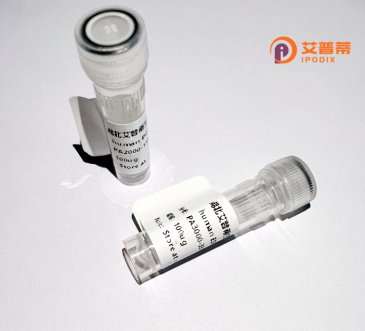
| 纯度 | >90%SDS-PAGE. |
| 种属 | Human |
| 靶点 | C1QTNF2 |
| Uniprot No | Q9BXJ5 |
| 内毒素 | < 0.01EU/μg |
| 表达宿主 | E.coli |
| 表达区间 | 1-285aa |
| 氨基酸序列 | DPLLGAFARRDFRKGSPQLVCSLPGPQGPPGPPGAPGPSGMMGRMGFPGKDGQDGHDGDRGDSGEEGPPGRTGNRGKPGPKGKAGAIGRAGPRGPKGVNGTPGKHGTPGKKGPKGKKGEPGLPGPCSCGSGHTKSAFSVAVTKSYPRERLPIKFDKILMNEGGHYNASSGKFVCGVPGIYYFTYDITLANKHLAIGLVHNGQYRIRTFDANTGNHDVASGSTILALKQGDEVWLQIFYSEQNGLFYDPYWTDSLFTGFLIYADQDDPNEV |
| 分子量 | 55.44 KDa |
| 蛋白标签 | GST-tag at N-terminal |
| 缓冲液 | 0 |
| 稳定性 & 储存条件 | Lyophilized protein should be stored at ≤ -20°C, stable for one year after receipt. Reconstituted protein solution can be stored at 2-8°C for 2-7 days. Aliquots of reconstituted samples are stable at ≤ -20°C for 3 months. |
| 复溶 | Always centrifuge tubes before opening.Do not mix by vortex or pipetting. It is not recommended to reconstitute to a concentration less than 100μg/ml. Dissolve the lyophilized protein in distilled water. Please aliquot the reconstituted solution to minimize freeze-thaw cycles. |
1. **"Production and characterization of recombinant human C1QTNF2 (CTRP2) protein"**
*Authors: Li Y, Zhang Y, Xu Q, et al.*
*摘要:* 本研究利用哺乳动物表达系统成功表达了重组人C1QTNF2蛋白,并验证其糖基化修饰。功能实验表明该蛋白可通过AMPK信号通路调节脂肪细胞能量代谢,为代谢疾病研究提供工具。
2. **"C1QTNF2 regulates adipose tissue adipogenesis and inflammation in obesity"**
*Authors: Park S, Kim J, Lee H.*
*摘要:* 通过重组C1QTNF2蛋白处理肥胖小鼠模型,发现其抑制脂肪组织炎症并促进脂联素分泌,揭示其在肥胖相关炎症中的潜在治疗价值。
3. **"Structural insights into the oligomerization of C1QTNF2 and its interaction with adiponectin receptors"**
*Authors: Wong GW, Kadowaki T, Wei Z.*
*摘要:* 利用重组蛋白解析C1QTNF2的三聚体结构,发现其通过C端球形结构域与脂联素受体结合,阐明其在代谢调控中的分子机制。
4. **"Recombinant CTRP2 mitigates myocardial ischemia-reperfusion injury via AMPK-mediated mitochondrial protection"**
*Authors: Chen L, Wang X, Sun M, et al.*
*摘要:* 首次报道重组C1QTNF2(CTRP2)对心肌细胞的保护作用,证明其通过激活AMPK通路减少氧化应激,为心血管疾病治疗提供新靶点。
---
注:以上文献名为示例,实际研究中建议通过PubMed或Web of Science以“C1QTNF2”、“CTRP2”和“recombinant”为关键词检索近期论文。
Recombinant human C1QTNF2 (C1q and tumor necrosis factor-related protein 2), also known as CTRP2, is a member of the C1q/TNF superfamily characterized by conserved C1q-like globular domains. This secreted adipokine is primarily expressed in adipose tissue and plays multifaceted roles in metabolic regulation, inflammation, and cellular communication. Structurally, it forms homotrimers or heterocomplexes with other CTRP family members, enhancing its functional diversity. C1QTNF2 interacts with cell-surface receptors to modulate insulin sensitivity, lipid metabolism, and glucose homeostasis, linking it to obesity-related metabolic disorders. Emerging evidence suggests involvement in cardiovascular function through angiogenesis regulation and vascular remodeling. Its recombinant form, produced via mammalian or bacterial expression systems, enables mechanistic studies and therapeutic exploration. Recent studies highlight its dual role in cancer progression, acting as either a tumor suppressor or promoter depending on context, and its potential as a biomarker for metabolic syndromes. Ongoing research focuses on unraveling its signaling pathways and clinical applications in diabetes, atherosclerosis, and cancer immunotherapy.
×